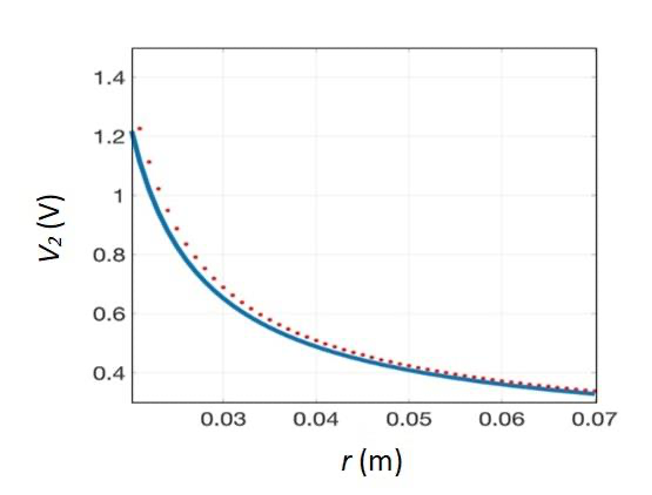Solid state resonant circuits and wireless electrical power propagation for mobile devices applications
DOI:
https://doi.org/10.37636/recit.v44314328Keywords:
Wireless energy, Resonant circuits, Power propagationAbstract
In this work, theoretical and experimental results of solid-state resonant circuits for the transmission and reception of wireless electrical energy, for applications in mobile devices are presented. Analytical expressions are found to calculate the voltage range as a function of the distance between the emitter and the load, as well as the current at the front end of an electromagnetic wave receiver. These expressions show the parameters to be varied to achieve a greater range in the transmission of wireless electrical energy. The transmitted voltage and current are measured by an electromagnetic wave receiver and compared with theoretical values, finding an excellent correspondence between the two.
Downloads
References
X. Lu, P. Wang, D. Niyato, D. I. Kim, and Z. Han, "Wireless Charging Technologies: Fundamentals, Standards, and Network Applications," IEEE Commun. Surv. Tutorials, vol. 18, no. 2, pp. 1413-1452, 2016. https://doi.org/10.1109/COMST.2015.2499783. DOI: https://doi.org/10.1109/COMST.2015.2499783
K. H. Yi, "Output voltage analysis of inductive wireless power transfer with series lc and llc resonance operations depending on coupling condition," Electron., vol. 9, no. 4, 2020. https://doi.org/10.3390/electronics9040592. DOI: https://doi.org/10.3390/electronics9040592
P.S. Riehl et al., "Wireless power systems for mobile devices supporting inductive and resonant operating modes," IEEE Trans. Microw. Theory Tech., vol. 63, no. 3, pp. 780-790, 2015. https://doi.org/10.1109/TMTT.2015.2398413. DOI: https://doi.org/10.1109/TMTT.2015.2398413
N. Tesla, "Experiments with altrnate current of very high frequency and their application to methods of artificial illumination," Columbia Coll., pp. 267-319, 1891. https://doi.org/10.1109/T-AIEE.1891.5570149. DOI: https://doi.org/10.1109/T-AIEE.1891.5570149
S. K. Oruganti and F. Bien, "Investigation of Near-Field Wireless Energy Transfer for Through Metal-Wall Applications," 2014 IEEE Wirel. Power Transf. Conf., pp. 247-250, 2014. https://doi.org/10.1109/WPT.2014.6839573 DOI: https://doi.org/10.1109/WPT.2014.6839573
S. Kim, Y. Lim, and S. Lee, "Magnetic Resonant Coupling Based Wireless Power Transfer System with In-Band Communication," no. May 2015, 2013. https://doi.org/10.5573/JSTS.2013.13.6.562 DOI: https://doi.org/10.5573/JSTS.2013.13.6.562
R. Kerid and H. Bourouina, "Analysis of Wireless Power Transfer System with New Resonant Circuit for High Efficiency Using Perforated Capacitors," Arab. J. Sci. Eng., vol. 44, no. 3, pp. 2445-2451, 2019. https://doi.org/10.1007/s13369-018-3579-2. DOI: https://doi.org/10.1007/s13369-018-3579-2
P. Sittithai, K. Phaebua, T. Lertwiriyaprapa, and P. Akkaraekthalin, "Magnetic field shaping technique for HF-RFID and NFC systems," Radioengineering, vol. 27, no. 1, pp. 121-128, 2019. https://doi.org/10.13164/re.2019.0121 DOI: https://doi.org/10.13164/re.2019.0121
R. A. Moffatt, "Wireless Transfer of Electric Power," Massachusetts Institute of Technology, 2009.
T. Supriyanto, A. Wulandari, and T. Firmansyah, "Design and Comparison Wireless Power Transfer Base on Copper (Cu) and Aluminium (Al) Rings Loop Magnetic Coupling," no. January 2016, pp. 6-10, 2017. https://doi.org/10.18178/IJIEE.2016.6.2.605 DOI: https://doi.org/10.18178/IJIEE.2016.6.2.605
C. K. Lee, W. X. Zhong, and S. Y. R. Hui, "Effects of Magnetic Coupling of Nonadjacent Resonators on Wireless Power Domino-Resonator Systems," vol. 27, no. 4, pp. 1905-1916, 2012. https://doi.org/10.1109/TPEL.2011.2169460 DOI: https://doi.org/10.1109/TPEL.2011.2169460
W. Zhou, S. Sandeep, P. Wu, P. Yang, W. Yu, and S. Y. Huang, "A wideband strongly coupled magnetic resonance wireless power transfer system and its circuit analysis," IEEE Microw. Wirel. Components Lett., vol. 28, no. 12, pp. 1152-1154, 2018. https://doi.org/10.1109/LMWC.2018.2876767 DOI: https://doi.org/10.1109/LMWC.2018.2876767
C. M. W. Basnayaka, D. N. K. Jayakody, A. Sharma, H.-C. Wang, and P. Muthuchidambaranathan, "Performance Study of Strongly Coupled Magnetic Resonance," 2019, [Online]. Available: http://arxiv.org/abs/1908.02541.
D. Knight, The self-resonance and self-capacitance of solenoid coils: applicable theory, models and calculation methods, no. May. 2016.
P. Azimi and H. Golnabi, "Precise Formulation of Electrical capacitance for a Cylindrical Capacitive Sensor," J. Appl. Sci., vol. 9, no. 8, pp. 1556-1561, 2009. https://doi.org/10.3923/jas.2009.1556.1561 DOI: https://doi.org/10.3923/jas.2009.1556.1561
H. Wheeler, "Formulas the Skin Effect," Proc. IRE, pp. 412-424, 1942. https://doi.org/10.1109/JRPROC.1942.232015 DOI: https://doi.org/10.1109/JRPROC.1942.232015

Published
How to Cite
Issue
Section
Categories
License
Copyright (c) 2021 Sergio Orendain Castro, Eduardo Murillo Bracamontes, Oscar Edel Contreras López, Alberto Hernández Maldonado

This work is licensed under a Creative Commons Attribution 4.0 International License.
The authors who publish in this journal accept the following conditions:
The authors retain the copyright and assign to the journal the right of the first publication, with the work registered with the Creative Commons Attribution license 4.0, which allows third parties to use what is published as long as they mention the authorship of the work and the first publication in this magazine.
Authors may make other independent and additional contractual agreements for the non-exclusive distribution of the version of the article published in this journal (eg, include it in an institutional repository or publish it in a book) as long as they clearly indicate that the work it was first published in this magazine.
Authors are allowed and encouraged to share their work online (for example: in institutional repositories or personal web pages) before and during the manuscript submission process, as it can lead to productive exchanges, greater and more quick citation of published work (see The Effect of Open Access).











